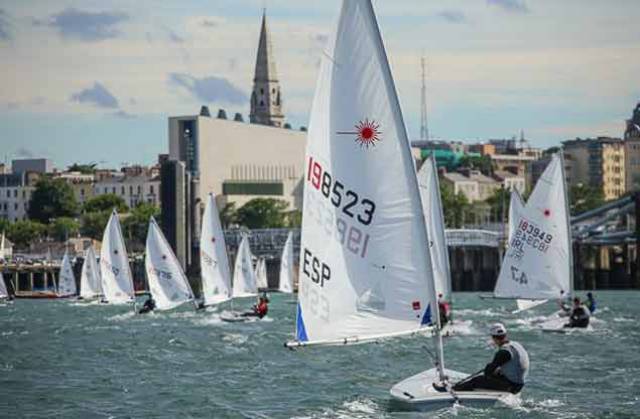“Only connect” urged the novelist E M Forster writes W M Nixon. But his idealistic concepts of emotional connection would be at some remove from the curiously coincidental nautical connections between writers Roddy Doyle and Jennifer Johnston, who are in public conversation for an hour on the final day of this week’s “Mountains to the Sea” dlr Book Festival in Dun Laoghaire.
Roddy Doyle is married to a direct descendant of Erskine Childers. And Jennifer Johnston is in private life Mrs Gilliland, married into a noted Derry family long involved with boats. Erskine Childers was of course best known as author of the 1903-published maritime thriller The Riddle of the Sands before he acquired fame as skipper of the Asgard in the 1914 Howth gun-running. And at that time, the leading sailor in the Gilliland family was Frank Gilliland, who was a pioneer in producing sailing directions and small boat charts for the northwest of Ireland, particularly Donegal, and recently came up on the radar again with Robbie Mason of Milford Haven undertaking a restoration of his 1938 Scottish fishing boat-style motor cruiser Blue Hills.


Both Childers and Gilliland were members of the oldest cruising organisation in the world, the 1880-founded Royal Cruising Club. But although both served in various sections of the Royal Naval Reserve through the 1914-18 War, by the time that war ended they had very different notions as to the future of Ireland in the post-war turbulence which eventually led to the War of Independence, the Partition which created Northern Ireland in 1921, and the Civil War in the new Irish Free State. Yet while they may have viewed some things very differently, in 1919 they combined on a small but significant project which was to have longterm effects on Irish sailing.
Both were acquainted with a sailor from Foynes called Conor O’Brien, Gilliland probably through the Naval Reserve connections, while Childers knew O’Brien from the time he had brought his ketch Kelpie along to assist in the 1914 gun-running. Whatever their origins, the connections were such that when the Foynes man sought to join the Royal Cruising Club in September 1919, he was proposed by Frank Gilliland and seconded by Erskine Childers, and duly got in.
Looked at across the series of events which occurred before and since, it was an extraordinary and unlikely combination of people and purposes. But it meant that Conor O’Brien now had access to a recognised channel for acknowledgement of his cruising achievements, which became serious when he departed Dun Laoghaire on June 20th 1923 for his voyage round the world south of the Great Capes with the new 42ft Baltimore-built Saoirse.
By this time, Erskine Childers had been executed by a firing squad of the Government of the new Irish Free State as an armed anti-Treaty rebel. And Frank Gilliland was on his way to becoming the Aide-de-Camp to the first Governor of Northern Ireland. But O’Brien sailed blithely along on his epic voyage, flying the tricolour ensign of the new Irish state whenever possible, yet submitting logs each year to the annual competition of the Royal Cruising Club.
Although many members of the RCC had severe doubts about having anything whatever to do with the new Ireland, the hugely-experienced adjudicator Claud Worth, RCC Vice Commodore, had little hesitation in awarding O’Brien the club’s premier trophy, the Challenge Cup, three years on the trot in recognition of his remarkable achievement.

Not only that, but when O’Brien wrote his book Across Three Oceans about the voyage, Claud Worth willingly supplied a foreword which gave the entire venture an official status which it has held ever since. In it, he memorably commented:
“Mr O’Brien’s plain seamanlike account is so modestly written that a casual reader might miss its full significance” wrote Worth. “But anyone who knows anything of the sea, following the course of the vessel day by day on the chart, will realize the good seamanship, vigilance and endurance required to drive this little bluff-bowed vessel, with her foul uncoppered bottom, at speeds from 150 to 170 miles per day, as well as handling the weight of wind and sea which must sometimes have been encountered”.

This level of support from a man regarded as God-like in his wisdom by the world of cruising was the ultimate level of recognition, and O’Brien’s reputation was secure, regardless of the fact that some found him at personal level to be a leading member of the Awkward Squad. It’s possible that his achievements were such that he would have so impressed Claud Worth regardless of his RCC membership. But the fact that he’d become a member in 1919 – albeit with the most unlikely combination of supporters – had greatly smoothed the way.
And as next Sunday’s exchange of ideas between Jennifer Johnston and Roddy Doyle is taking place beside the harbour where Saoirse’s great voyage began and ended over the space of exactly two years between 1923 and 1925, the coincidences are complete. Their conversation is on Sunday March 25th at noon in dlr Lexicon Level 4, booking recommended.
































































